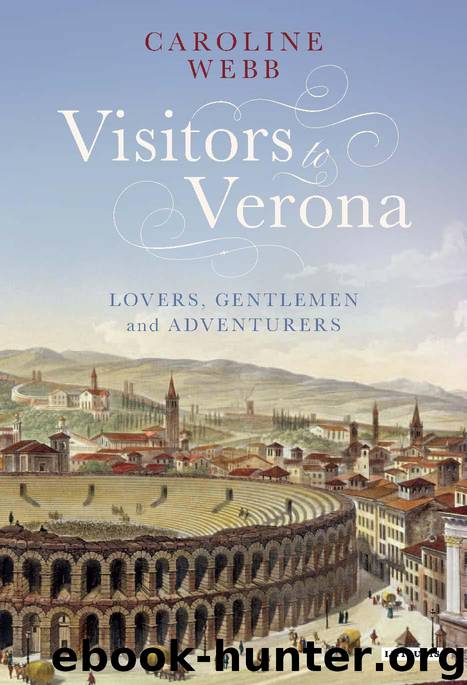Visitors to Verona: Lovers, Gentlemen and Adventurers by Webb Caroline

Author:Webb, Caroline [Webb, Caroline]
Language: eng
Format: mobi, epub
ISBN: 9781786720801
Publisher: I.B.Tauris
Published: 2016-12-17T16:00:00+00:00
CHAPTER 13
San Zeno Maggiore
But it is, I think, the church of San Zenone,
with its detached campanile of alternate lines of brick and marble,
that strikes as it were the keynote of this city of antiquity and romance. 1
Edward Hutton , Italy and the Italians, 1903
E DWARD HUTTON, ITALOPHILE, travel writer and art historian, thought the church of San Zeno Maggiore, also known as San Zenone, ‘by far the most interesting church in Verona, and […] one of the finest Romanesque buildings in Italy’. 2 There was a church on the site in the ninth century, but the present building dates mostly from the twelfth century and was finally completed in about 1390. Not everyone viewed it as enthusiastically as Hutton; it was not really until John Ruskin championed it as an outstanding example of medieval Romanesque architecture that the merits of San Zeno became more widely recognized. Earlier travellers tended to comment on specific features such as the church’s ancient bronze doors or the enormous porphyry basin that now stands near the west end, rather than remarking on the architectural character of the building itself.
In 1816 Joseph Woods, an architect by training, was one of the first to consider San Zeno within its historical context. ‘The most interesting example at Verona to the antiquary, as a specimen of the architecture of the depth of the middle ages, is the church of S. Zeno. It is a most curious edifice, both externally and internally.’ 3 About 20 years later, Hume Weatherhead was less impressed, saying that as a Gothic building San Zeno
[…] affords samples of rudeness of sculpture not often to be met with. The visitor has only to observe that which was meant to adorn each side of the front portal, to see from what barbarous beginnings an art of so much sublime beauty may regenerate. 4
Some time later, in 1854, the architect George Edmund Street set out to visit the church and, although finding it thoroughly neglected, found much to praise.
A longish walk through squalid suburbs leads us to the open space in front of the noble basilica of San Zenone; it is a desolate waste-looking space, and the poor, old, uncared-for church looks now as though its day was well-nigh past; as if neglect and apathy were all that men could give now where once they were wont to lavish so much of their treasure, and love, and art.
He also found the cloister ‘in a very sad state of filth, neglected and unused, and will, I fear, ere long become ruinous’. Despite all this, San Zeno’s
[…] proportions are so very grand, and its detail generally so perfect, that I think it may certainly be regarded as on the whole a noble example of its class; indeed, except the very best Gothic work of the best period, I doubt whether any work of the Middle Ages so much commands respect and admiration as this Lombard work. 5
It is evident that architecturally well-informed visitors like Street used the terms Gothic or Lombard variously to describe this particular church.
Download
Visitors to Verona: Lovers, Gentlemen and Adventurers by Webb Caroline.epub
This site does not store any files on its server. We only index and link to content provided by other sites. Please contact the content providers to delete copyright contents if any and email us, we'll remove relevant links or contents immediately.
| African | Asian |
| Australian & Oceanian | Canadian |
| Caribbean & Latin American | European |
| Jewish | Middle Eastern |
| Russian | United States |
4 3 2 1: A Novel by Paul Auster(12284)
The handmaid's tale by Margaret Atwood(7679)
Giovanni's Room by James Baldwin(7192)
Asking the Right Questions: A Guide to Critical Thinking by M. Neil Browne & Stuart M. Keeley(5636)
Big Magic: Creative Living Beyond Fear by Elizabeth Gilbert(5614)
Ego Is the Enemy by Ryan Holiday(5294)
The Body: A Guide for Occupants by Bill Bryson(4974)
On Writing A Memoir of the Craft by Stephen King(4863)
Ken Follett - World without end by Ken Follett(4645)
Adulting by Kelly Williams Brown(4487)
Bluets by Maggie Nelson(4474)
Eat That Frog! by Brian Tracy(4435)
Guilty Pleasures by Laurell K Hamilton(4360)
The Poetry of Pablo Neruda by Pablo Neruda(4039)
Alive: The Story of the Andes Survivors by Piers Paul Read(3969)
White Noise - A Novel by Don DeLillo(3954)
Fingerprints of the Gods by Graham Hancock(3942)
The Book of Joy by Dalai Lama(3901)
The Bookshop by Penelope Fitzgerald(3776)
